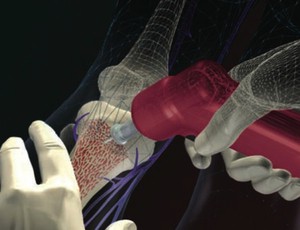Intraosseous access training in rural and remote areas – Full Text

“This technical report describes the delivery of a fundamental skills workshop to provide hands-on training to rural and remote healthcare professionals using 3D-printed simulators purposefully designed following design-to-cost principles” Siraj et al (2022).
Intraosseous infusion skills training – Full Text

“This technical report aims to address these concerns by describing the development of an alternative, affordable, and reliable IO drilling system for training use” Clarke et al (2022).
Intraosseous access simulated training

“Simulation-based training improved the IO access using a semiautomatic or a manual device, regardless of the experience or status of the trainees” Alkhalil et al (2022).
IO needle placement – Full Text

“The CIC approach led to the manufacturing of simple and advanced IO simulators that would suit a training plan catered to teach the IO access and infusion procedure decentrally to paramedics-in-training” Sivanathan et al (2022).
Intraosseous infusion complication – Full Text

“A dermatologic exam revealed multiple small, tender, firm, chalky-white papules with surrounding erythema, in addition to two erythematous macules superior and medial to the papular lesions, corresponding to prior intraosseous access sites” Marinelli et al (2022).
3D printed intraosseous line placement trainer

“After a task trainer has been used to practice a procedure, such as intraosseous line placement, the tissue media, molds, and bones are reclaimable and may be reused to create a fresh task trainer, free of puncture sites and manipulation defects, for use in subsequent training sessions” Markin et al (2022).
High-fidelity intraosseous training – Full Text

“High-fidelity training with soft-preserved cadavers may be the most effective way to prepare pcPA students to perform endotracheal intubation and intraosseous infusion” Moon et al (2022).
Nursing attitude towards intraosseous access – Full Text

“Prehospital and emergency department nursing staff are aware of the importance of intraosseous access and understand the need for additional education and certification in this field” Žunkovič et al (2022).
Safety of intraosseous access in neonates – Full Text

“Within this surveillance study, IO access in neonates was feasible and safe. IO access is an important alternative for vascular access in neonates” Schwindt et al (2022).
Becton Dickinson recalls intraosseous needle – FDA Alert

“Becton Dickinson is recalling the BD Intraosseous Needle Set Kits, BD Intraosseous Manual Driver Kits, and BD Intraosseous Powered Drivers for three separate issues” FDA (2022).
Intraosseous access device comparison – Full Text

“We sought to compare the efficacy and safety of the NIO to an established, well-studied device, the EZIO, when used for resuscitative vascular access in the emergency department” Drumheller et al (2022).
Intraosseous infusion technique explained

“The intraosseous infusion procedure is easy and the learning curve is short, making it the best alternative when traditional intravenous access is not possible or delayed” Meynet et al (2022).
Intraosseous access in pediatrics

“Successful prehospital IO access was achieved in 83.7% of patients. The median time required to achieve IO access was 4 minutes (IQR 3-7) and mean duration of IO function was 27.6 minutes (SD: 14.8)” Garabon et al (2022).
Intraosseous needle placement – Full Text

“Intraosseous (IO) access is critical in resuscitation, providing rapid access when peripheral vascular attempts fail. Unfortunately, misplacement commonly occurs, leading to possible fluid extravasation and tissue necrosis” Kyle et al (2022).
Emergency vascular access

“Contraindications and complications of I.O and of ultrasound-guided CVP positioning are limited” Gerlando et al (2021).
Timely access to intraosseous access devices – Full Text

“Task-based package organization of neonatal emergency backpacks is feasible and might be superior to ABC-/material-oriented storage” Sommer et al (2021).
Intraosseous access in pediatric patients

“Intraosseous access was associated with decreased survival among pediatric non-traumatic OHCA” Besserer et al (2021).
Intraosseous device review

“In our study, Army combat medics learned how to use both devices rapidly but felt the NIO automatic IO device easier to use and overwhelmingly preferred this device” Lange et al (2021).
Intraosseous access complications

“Our review identified a complication rate of 2.7%, with complications including compartment syndrome, needle breakage, and a previously unreported cutaneous complication of traumatic bullae” Konopka et al (2021).
Intraosseous vascular access device comparison

“Each of these devices provides an effective route for fluid resuscitation, drug delivery, laboratory evaluation, and shortening the timeframe for established vascular access, provided that the person obtaining the access is acquainted with the use of the device” Drozd et al (2021).
Tibial intraosseous drug administration

“Our aim was to determine whether prehospital administration of resuscitative medications via the IO route was associated with lower rates of return of spontaneous circulation (ROSC) and survival to hospital discharge than peripheral intravenous (IV) infusion in the setting of OHCA” Hamam et al (2021).
Intraosseous valproic acid administration – Full Text

“IO-delivered VPA is noninferior to intravenous administration and is a viable option in emergent situations when intravenous access is unattainable” Biesterveld et al (2021).
Double site intraosseous blood transfusion

“Dual anatomic site, pressure bag driven, intraosseous blood transfusion approximately doubles flow rates without evidence of clinical complications or hemolysis” Sulava et al (2021).
Complications of intraosseous access

“Intraosseous (IO) access is an effective surrogate for intravascular access in critically ill patients. We present 2 cases of IO complications” Arakawa et al (2021).
Intraosseous access in newborns consideration of alternative sites

“Proximal humeral head and distal femoral end might be alternative IO areas which may lead to further IO puncture sites in neonates” Eifinger et al (2021).
Intraosseous thrombolysis following PE and cardiac arrest – Full Text

“This case demonstrates successful thrombolysis through an intraosseous route, with a good outcome despite poor prognostic factors” Nweze et al (2020).
Intraosseous administration of hydroxocobalamin for cyanide poisoning

“This appears to be only the second reported human case of intraosseous hydroxocobalamin administration” Mastenbrook et al (2021).
Comparison of intraosseous access and central venous catheterization

“IO access is a safe, rapid, and effective technique for gaining vascular access in critically ill adults with inaccessible peripheral veins in the emergency departments” Liu et al (2021).
Intraosseous versus IV access during cardiopulmonary resuscitation – Full Text

“The meta-analysis revealed no significant association between types of vascular access and neurological outcomes at hospital discharge among OHCA patients” Hsieh et al (2021).
Intraosseous vascular access maintained for up to 48 hours

“This is the first known study examining the safety of IO access over a 48-h dwell time” Philbeck et al (2021).

